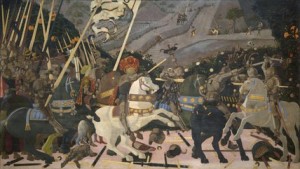Paolo Uccello: The Battle of San Romano: About 1438-40
We are looking at a battle scene – although quite a bloodless one. A large army of knights led by a man on a white horse, are coming to blows with a knight on the right hand side of the picture – although we get the impression that there are more of these soldiers just off the picture. Broken lances and bits of armour litter the field of battle, and in the background we can see more knights, men with lances and men with crossbows. Separating the foreground from the background is a hedge of some sort, with roses, oranges and pomegranates.
First things first. The painting was commissioned to celebrate a victory between the army of Florence, against that of another Italian city, Siena, in 1432. It’s one of three done by Uccello, the others being in the Louvre in Paris and the Uffizi in Florence. The Florentine army was commanded by Niccolo da Tolentino, and we can tell him by the general’s baton that he holds in his right hand. His page rides alongside him carrying his helmet.
The knights are actually wearing ceremonial armour rather than battle armour, and when the picture was painted that would have been bright silver. So we can imagine with the silver armour, the lush greens of the hedge and trees, and the flowers and fruits, this would have looked almost tapestry like.
It was originally painted to go into a curved gothic arch – if you look closely you can see the curves around the edge of the orange tree on the right, and the third lance in on the left – but at some point the tops of the arches were taken off and the painting was made with a square top. The painting and its two companions were commissioned by the Bartolini Salimbeni family in Florence, but were acquired – basically stolen – by Lorenzo de Medici in about 1485. It was one of the early purchases of the new National Gallery, being bought in 1857.
The key words from the description earlier are ‘foreground’ and ‘background’. The pictures we’ve seen thus far didn’t use perspective – the trick of getting us to think a flat surface has depth. Uccello was fascinated by this idea and we can see here how he tries to get to grips with it. The broken lances lead us to a single point just under the reins of the white horse. There’s foreshortening – where, when you look along something, it appears shorter which Uccello has done with the dead knight on the ground (although not entirely successfully – the knight’s feet should appear larger.
Perspective becomes the dominant way of representing the world for Western Art for nearly 500 years, until modern art movements began to subvert it.
Giorgio Vasari, who wrote a book of biographies of renaissance artists in the 1550s, said that Uccello would work on perspective throughout the night, ignoring his wife’s entreaties to come to bed. That either shows incredible dedication by Uccello or the fact that he just didn’t get on with his wife. So let’s move on to something that we do know was commissioned by a loving husband – Van Eyck’s Arnolfini portrait.


